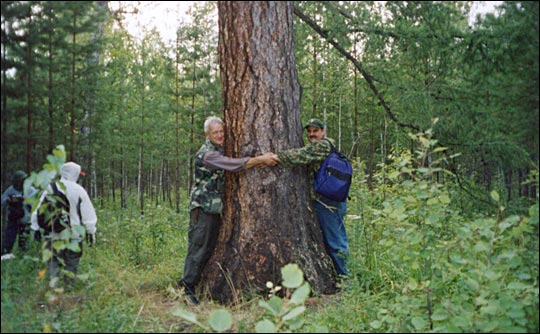

|
Nowhere on Earth is warming faster than the Arctic. In northern Siberia, average temperatures have risen 1 to 3°C (3 to 5°F) over the past 30 years, whereas the worldwide average increase in that time is 0.6°C (1°F). As Earth’s temperature rises, what is happening to the great northern forests of Siberia? Thick stands of spruce, pine, aspen, and larch trees occupy a vast stretch of land across northern Asia and Europe, straddling roughly half of the Arctic Circle. Will the trees in this ecosystem (called taiga) begin to grow faster and to gradually extend their reach farther north into the treeless tundra, as some scientists predict? Or will hotter, drier conditions stress the trees, thereby inhibiting growth and leaving the forest prone to invasive species and wildfires, as new evidence suggests? A small international team of scientists from NASA and Russia’s Academy of Science are going to find answers. Beginning July 28, 2007, the team of six remote sensing and forest ecosystem scientists set off on a three-week scientific expedition through the heart of the remote, wild forests of Siberia. They are traveling southward down the Kochechum River observing the gradual transition from tundra to taiga, taking inventory of plant species along the way, and making ground-truth measurements to validate data being collected by several NASA satellites flying 700 kilometers overhead. The team is led by Jon Ranson, head of the Biospheric Sciences Branch at NASA’s Goddard Space Flight Center, and Slava Kharuk, of the Sukachev Forest Institute. The two have been collaborating since 1991, when Ranson first visited the Forest Institute's field camp. This makes the pair’s seventh Siberian expedition together. |
Where in the World On the Central Siberian Plateau, a wilderness of tundra gradually transitions to the northern forests known as taiga. At the end of July 2007, a team of American and Russian scientists set off down the Kochechum River to study this remote landscape. This image tracks their journey down the river. |
||
 |
|||
|
The Russian forest is of great interest to scientists studying Earth’s carbon cycle, land ecosystems, and biodiversity. The forested area is so immense that it contains about 43 percent of the world’s temperate and boreal forests. Yet scientists estimate that two-thirds of its area is being disturbed by natural or man-made stresses. The team’s expedition to study these forests starts above the Arctic Circle near the source of the Kochechum River. There are no roads there, so the team will fly in by helicopter. On the ground they will pile their gear into the three boats they brought, and then set off down river. They will ride the river for 15 days and end their trek at Tura, a small town of about 10,000 people. Until they reach town, they will be completely self-sufficient. What will they find? A main mission objective is to validate the forest height measurements made by the Geosciences Laser Altimeter System (GLAS) onboard NASA’s ICESat satellite. To do this, the team must bring their boats to shore and traverse through rugged terrain, carrying all their equipment, to pinpoint the precise locations measured by ICESat’s laser. At each site they will use standard forestry equipment (diameter tapes, 50-meter tapes, and laser angle-finder devices) to collect data to compare to the satellite observations. The team expects to face challenges. Yet they also will experience natural wonders such as the continual daylight of summer in the far North. Through it all, their satellite phone will be their only link to civilization. Jon and Slava will use the phone to provide daily updates to NASA’s Earth Observatory Website. So check back here often to follow the scientists’ ride down the Kochechum through the heart of Siberian wilderness, and to learn what they learn in near-real time.
|
In their seventh expedition together, Slava Kharuk (left) and Jon Ranson (right) are embarking on a new study of the landscape between the Arctic tundra and the taiga forest of northern Siberia. It takes both scienitsts’ arms to encircle a large tree in the taiga, an act that symbolizes not only their friendship, but also the close working relationship between the Russian and American research teams. |
||